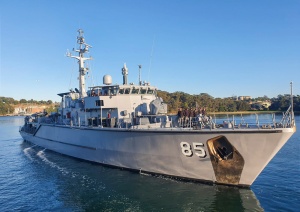
HMAS Gascoyne (II) is the fourth of the six Huon Class Minehunters (MHC). She was launched on11 March 2000 and is based in Sydney at HMAS Waterhen. A large minehunter by world standards, the 720 tonne, 52.5 metre MHC is propelled by a V8 diesel engine driving a controllable pitch propeller in transit, and three retractable thrusters while minehunting.
Gascoyne is the second RAN ship to carry the name. HMAS Gascoyne (I) was Australia"s first River Class Anti-Submarine Frigate that served with distinction during World War II. In October 1944, while surveying for the US landings at Leyte Gulf, Gascoyne (I) experienced 39 air attacks and saw 30 Japanese aircraft destroyed. In July 1945, she provided bombardment support for the Australian troop landings in the Balikpapan area of Borneo.
Origins of the Gascoyne name
The Gascoyne is an area of undefined boundaries in the north west of Western Australia. The area takes its name from the Gascoyne River, Western Australia"s longest river (820 km) that lays approximately 800 km north of Perth. George Grey named it in 1839 “after my friend, CAPT J. Gascoyne”. The original HMAS Gascoyne was named after this river.
The Gascoyne Region is about twice the size of Tasmania and incorporates some key coastal geographic features including: Ningaloo Reef and Marine Park, Coral Bay, Cape Range National Park and the Shark Bay World Heritage Area. The region also contains Mt Augustus - the world"s largest monocline.
While the region’s population is only 9700, it still attracts a number of tourists and mid-term visitors, which provide a significant input to the region’s economic base. Fishing, mining, horticulture and pastoralism also contribute to the Gascoyne region’s economy.
Specifications
 |
| Commanding Officer |
Lieutenant Commander Lachlan Browne |
|---|---|
| Class |
Huon Class |
| Type |
Minehunter, Coastal (MHC) |
| Role | Mine Warfare |
| Pennant |
M 85 |
| International Callsign |
VLTF |
| Motto |
Return to the Sea |
| Home Port |
HMAS Waterhen |
| Builder |
ADI Newcastle |
| Launched |
11 March 2000 |
| Commissioned |
2 June 2001 |
| Dimensions & Displacement | |
| Displacement | 732 tonnes |
| Length | 52.5 metres |
| Beam | 9.9 metres |
| Draught | 3 metres |
| Performance | |
| Speed | 14 knots |
| Range | 1,600 nautical miles |
| Complement | |
| Crew | 46 |
| Propulsion | |
| Machinery |
|
| Armament | |
| Guns | 1 x MSI DS 30B 30mm |
| Physical Countermeasures |
|
| Electronic Countermeasures | AWADI Prism |
| Radars | Kelvin Hughes 1007 |
| Sonars | GEC-Marconi Type 2093 |
| Combat Data Systems | GEC-Marconi Nautis 2M |
| Weapon Control Systems | Radamec 1400N optronic surveillance system |
| Awards | |
| Inherited Battle Honours |
|
| Resources | |
| News Articles |
Defence News |
| Image Gallery |
HMAS Gascoyne (II) |

